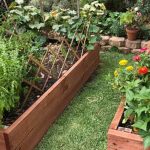Are pallets safe for vegetable gardens? Using pallets as a gardening solution has become increasingly popular in recent years. They offer numerous benefits, such as maximizing limited space and providing a rustic aesthetic. However, there are also potential concerns about the safety of using pallets for growing edible plants. In this article, we will explore the use of pallets in vegetable gardens, discussing both the benefits and potential risks associated with their use.
When it comes to using pallets for vegetable gardens, one of the primary considerations is ensuring that the pallets are safe and free from harmful chemicals. Additionally, preparing the pallets for use in the garden is essential to prevent decay and pest infestations. This article will provide guidance on selecting the right pallets for your vegetable garden and preparing them for use, as well as addressing any potential risks or concerns that may arise.
In addition to exploring safety considerations, we will also delve into practical tips for utilizing pallets in gardening, including vertical gardening and constructing garden beds. By addressing both safety concerns and practical applications, this article aims to provide a comprehensive guide to successfully using pallets in vegetable gardens while prioritizing safety.
Selecting the Right Pallets for Your Vegetable Garden
When using pallets for vegetable gardening, it is crucial to select the appropriate type of pallets to ensure the safety and well-being of your plants. Untreated, chemical-free pallets are essential as they eliminate the risk of harmful substances leaching into the soil and impacting the vegetables grown. It is important to note that some pallets are treated with chemicals or pesticides, which can contaminate the soil and ultimately affect the edibility of the produce.
Identifying safe pallets for gardening involves checking for specific markings or labels on the pallet itself. Look for pallets that are stamped with “HT,” which stands for heat-treated, indicating that they have been treated using heat rather than chemicals. Additionally, avoiding pallets that have a dark, discolored appearance or a strong chemical odor is crucial in selecting safe and suitable options for your vegetable garden.
| Safe Pallet Identification | Description |
|---|---|
| Check for “HT” Stamp | Pallet has been heat-treated instead of chemically treated |
| Avoid Discoloration and Odor | Avoid dark or discolored pallets with a strong chemical smell |
Preparing Pallets for Use in the Garden
When using pallets for your vegetable garden, it is crucial to properly prepare them for use. One of the first steps is to ensure that you are selecting untreated, chemical-free pallets. Chemical treatments and pesticides used on some pallets can leach into the soil and be absorbed by your vegetables, posing potential health risks. Look for pallets that are labeled with “HT,” which indicates that they have been heat-treated rather than chemically treated.
After selecting safe pallets, the next step is to clean and sanitize them before use. Pallets can often be dirty or contaminated from their previous use in shipping and storage. This can be done by scrubbing the pallet with a mixture of water and vinegar or a mild bleach solution, then allowing it to dry completely before use.
In addition to cleaning the pallets, it is also important to pre-treat them to prevent decay and pest infestations. This can be done by applying a non-toxic wood sealant or stain to the pallet, focusing on any areas that may come into contact with soil or water. Ensuring that your pallets are clean and well-protected will help maintain a healthy environment for your vegetable garden.
| Preparation Step | Description |
|---|---|
| Selecting Safe Pallets | Choose untreated, chemical-free pallets labeled with “HT.” |
| Cleaning and Sanitizing | Scrub the pallet with water/vinegar or mild bleach solution. |
| Pre-Treating Pallets | Apply non-toxic wood sealant or stain to prevent decay and pests. |
Utilizing Pallets in Vertical Gardening
When it comes to maximizing space and adding a unique aesthetic to your vegetable garden, utilizing pallets in vertical gardening can be a game-changer. Not only does it allow you to grow more plants in a limited area, but it also provides a great solution for those with small outdoor spaces or no access to a traditional garden bed. Below are some creative ways to repurpose pallets for vertical vegetable gardens.
Creative Repurposing
One of the most popular and visually appealing ways to utilize pallets in vertical gardening is by creating a living wall. By standing the pallet upright and filling the slats with potting soil, you can plant various vegetables, herbs, or flowers in each section. This not only adds greenery to your garden but also serves as a natural privacy screen or backdrop.
Another creative use of pallets in vertical gardening is constructing a tiered planter. By disassembling the pallet and reconfiguring its boards into different levels, you can create a multi-level planter for your vegetables. This not only saves space but also allows for effective drainage between each tier.
Maximizing Limited Space
Vertical gardening with pallets is especially beneficial for those dealing with limited outdoor space. Whether you have a small balcony, patio, or even just a narrow strip of yard, utilizing pallets allows you to make the most of what space you have available. Additionally, using pallets provides an opportunity for gardening in unconventional areas such as against fences or walls.
Building a Pallet Garden Bed
When building a pallet garden bed, it is essential to follow certain steps to ensure stability, durability, and safety. Pallets can be a great resource for creating raised garden beds, as they allow for proper drainage and can help to keep out pests. Here are some tips for constructing a pallet garden bed:
Step-by-Step Guide
To begin, you will need to gather your materials, including untreated pallets, a saw, drill, screws, and landscaping fabric. Start by disassembling the pallets using a saw to remove the boards. Then, arrange the boards to form the desired size and shape of your raised bed. Use the drill and screws to secure the boards together at the corners and along the edges. Finally, line the bottom of the bed with landscaping fabric before filling it with soil.
Ensuring Stability
It is important to ensure that your pallet garden bed is stable and secure before adding soil and plants. Choose sturdy pallets that are free from rot or damage, as these could compromise the structural integrity of the bed over time. Additionally, consider reinforcing the corners with additional braces or screws for added stability.
Tips for Longevity
To extend the lifespan of your pallet garden bed, consider treating the wood with a natural sealant or paint that is safe for use around edible plants. This can help to protect the wood from decay and prolong its usability in your vegetable garden. Additionally, regularly inspecting your pallet garden bed for any signs of wear or damage can help prevent potential issues such as collapse or tipping over.
By following these guidelines for building a pallet garden bed, you can create a safe and productive space for growing vegetables while making use of repurposed materials. With proper construction and maintenance, pallet garden beds can be a sustainable and practical addition to any garden environment.
Potential Risks and Concerns
When using pallets in vegetable gardens, there are certain potential risks and concerns that gardeners should be aware of in order to ensure the safety of their plants and themselves. It is important to address these concerns and take necessary precautions to mitigate any risks associated with using pallets in the garden.
One potential risk of using pallets for gardening is the presence of harmful chemicals or treatments that may have been applied to the wood. To minimize this risk, it is crucial to select untreated, chemical-free pallets for use in vegetable gardens. Look for pallets that are labeled as HT (heat-treated) rather than MB (methyl bromide) which indicates they have been treated with potentially harmful chemicals.
Another concern when using pallets in the garden is the potential for decay and pest infestations. Pallets that have not been properly cleaned, sanitized, and pre-treated can deteriorate over time, leading to structural instability and inviting pests into the garden. Taking steps to clean and sanitize the pallets before use, as well as pre-treating them with a protective sealant or paint, can help prevent these issues.
In addition to chemical treatments and decay, there may also be physical safety concerns when repurposing pallets for gardening. Splinters, rough edges, and unstable construction can pose a risk to gardeners working with pallets. It’s important to carefully inspect and prepare the pallets for use, addressing any potential safety hazards before constructing vertical gardens or garden beds.
Maintaining Your Pallet Garden
Once your vegetable garden is set up using pallets, it’s essential to ensure proper maintenance to keep it thriving. Proper watering, fertilization, and pest control are crucial aspects of maintaining a healthy pallet garden. Since pallets can be more susceptible to certain issues, it’s important to pay extra attention to the care of your garden.
When it comes to watering your pallet garden, be mindful of the water drainage. Pallets may not have sufficient drainage on their own, so you may need to make adjustments to avoid waterlogging the plants. Additionally, since pallets are elevated off the ground, they may dry out faster than traditional gardens, so consistent monitoring of soil moisture is necessary.
Fertilization is also an important aspect of maintaining a healthy pallet garden. Because the soil in pallets can become depleted more quickly due to limited space and nutrients, regular fertilization is crucial for keeping your plants healthy and productive. Choose organic fertilizers that are suitable for vegetable gardens and follow the recommended application rates for best results.
Lastly, implementing a pest control plan is essential for preventing common issues associated with pallet gardens such as pests and diseases. Regularly inspect your plants for signs of infestation and take appropriate measures using organic pest control methods to keep your garden thriving.
By staying on top of proper maintenance techniques in a pallet garden bed, you can ensure that your vegetables will flourish throughout the growing season. With attention to detail and regular care, you can prevent common issues associated with pallet gardens while enjoying a bountiful harvest from your innovative gardening setup.
Conclusion
In conclusion, using pallets for vegetable gardens can be a practical and creative solution for maximizing space and creating a unique gardening environment. However, it is crucial to prioritize safety when utilizing pallets in the garden. By selecting untreated, chemical-free pallets and properly preparing them for use, the potential risks associated with using pallets in vegetable gardens can be greatly minimized.
When considering the safety of using pallets for vegetable gardening, it is essential to be aware of any potential risks and concerns. Addressing issues such as decay, pest infestations, and chemical exposure requires careful consideration and proactive measures. By taking the necessary precautions and regularly maintaining the pallet garden, these risks can be mitigated effectively.
Ultimately, while there are potential risks associated with using pallets in vegetable gardens, with proper care and attention to safety considerations, it is possible to create a successful and safe garden environment. Whether you choose to repurpose pallets for vertical gardening or construct a raised garden bed from pallets, being mindful of safety guidelines will allow you to enjoy the benefits of using pallets in your vegetable garden without compromising on safety.
Frequently Asked Questions
How Do I Know if My Garden Pallets Are Safe?
To determine if your garden pallets are safe, you should check for any visible signs of damage, rot, or discoloration. Inspect for any chemical spills or stains, as well as any labels or markings that indicate the type of treatment the pallets have undergone.
It’s also important to know the history of the pallets – where they were used and what they were used for – to ensure they haven’t been exposed to harmful substances.
Do Pallets Leach Chemicals Into Soil?
Yes, pallets can leach chemicals into the soil, especially if they have been chemically treated. Chemical treatments such as fumigation with methyl bromide or chemical preservatives like creosote and pentachlorophenol can leach into the soil and potentially contaminate it. This can be harmful to plants, animals, and people who come into contact with the soil.
How Do You Tell if Pallets Are Chemically Treated?
To tell if pallets are chemically treated, look for an IPPC (International Plant Protection Convention) stamp which indicates that they have been heat-treated or fumigated with methyl bromide. If a pallet has been chemically treated with preservatives like creosote or pentachlorophenol, it may have a dark brown or greenish tint and a strong odor.
There might also be specific markings on the pallet indicating its treatment with these chemicals. If in doubt, it’s best to seek information from the manufacturer or supplier of the pallets.

If you’re looking to get into vegetable gardening, or are just looking for some tips on how to make your current garden better, then you’ve come to the right place! My name is Ethel and I have been gardening for years. In this blog, I’m going to share with you some of my best tips on how to create a successful vegetable garden.





